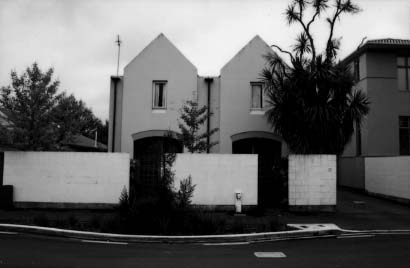| Our Environment: Issue 13 Summer 1997 |
Changing Face Of The Inner City
Increasing residential development is changing the face of Christchurch's inner city.
The number of people living within the four avenues
increased by 16 per cent in the five years between 1991 and 1996, twice the growth rate of
the city as a whole. Between July 1991 and June 1997 571 new houses were constructed in
the same area. 
Planning policy for the city over the last 30 years has looked to encourage inner city living. There are real benefits to be gained in supporting the commercial activity of the central city. People can live close to work and avoid long distance commuting. It puts people back into the heart of the city, restoring a sense of community, as well as supporting facilities and services existing in the area.
Greater development and a growing population does, however, mean change for the local environment. Much of the existing housing stock is older and design and architectural styles often differ from those of new housing.
Townhouses and apartment buildings tend to be larger, closer together and more prominent in the landscape than the older housing stock they replace. With greater building density, issues of design become particularly important, the way buildings look, the way they relate to neighbouring properties and the contrast of old and new.
The growing population also places demands on facilities such as parks and schools. As older houses are moved and sites are cleared ready for new development, existing trees and other vegetation is often removed and with more buildings replacing them, less space remains for replacement planting.
The resident community is also changing with the introduction of new housing and a growing trend to inner city living. Older and cheap rental accommodation is often replaced by more expensive townhouses and apartments. The loss of boarding house accommodation in particular has been noticeable in recent years in the eastern inner city. For those unable to afford alternative accommodation the consequences can be severe.
These issues extend beyond the responsibilities of inner city land owners and the realm of town planning, but do reflect genuine difficulties confronting this community.
Successful redevelopment of the inner city therefore becomes a matter of balance. Inner city residential development can have positive affects for the city but care needs to be taken to ensure the character and uniqueness of this urban environment is not destroyed for those who visit or live within it.
The City Council is therefore working to promote both the provision of affordable accommodation and good urban design in the inner city. With the assistance of local architects, guidelines are being prepared to promote good design practice. These guidelines will address issues in relation to individual properties such as the following:
- outdoor space
- access to sunshine
- carparking
- safety and security
- privacy
It is intended that these guidelines will also address the relationship with neighbouring properties, considering issues such as shading and screening and also the context of the wider community.
In addition, a Council working party has been actively pursuing the provision of affordable accommodation in the inner city. The Council has recently purchased a series of motels and lease negotiations are being completed to secure the provision of low cost accommodation. Other similar initiatives are also being investigated, directed particularly at meeting the needs of elderly, single people living in this area of the city.
Ken Gimblett
Senior Planner, Planning Policy
| Our Environment Index |